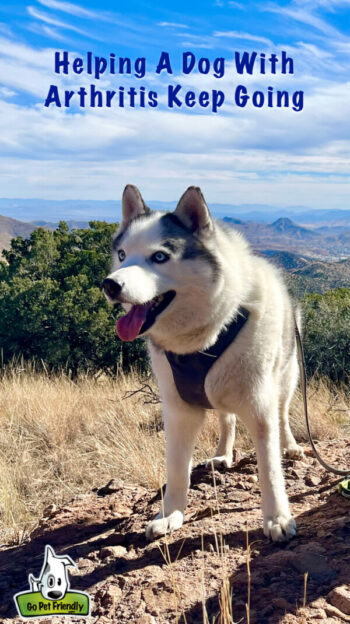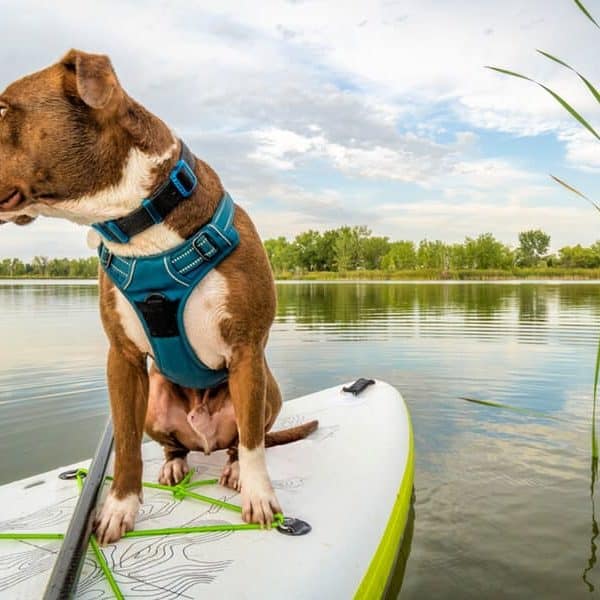Arthritis is often our first sign that our dogs are getting older. And, while no one likes to admit our pets are aging, there is a lot we can do to keep them comfortable and active! If your dog is showing signs of arthritis, we’re happy to share how we’ve helped our dogs to keep enjoying our adventures.
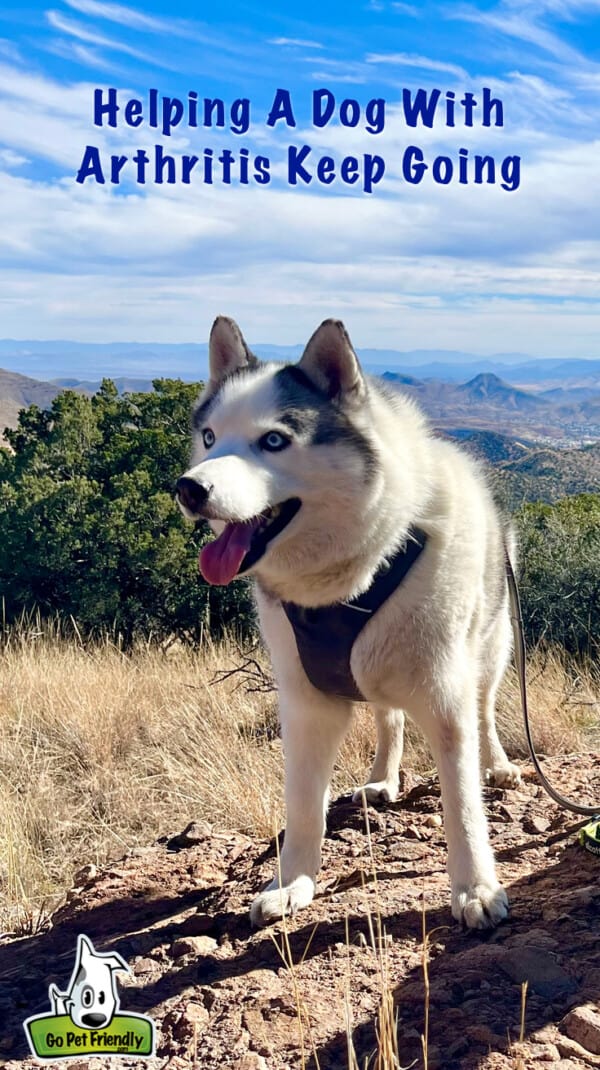
Disclosure: I’m not a veterinarian – just a concerned pet parent doing her best to take care of her dogs. If you suspect your pet is developing arthritis, you should talk to your veterinarian about ways to help.
When we launched this website and jumped in our motorhome our dogs were pups! We traveled full-time for 12 years, and during that time the boys developed “age-related” conditions. For Buster, that meant dealing with arthritis. So we learned as much as we could to help him continue enjoying our travels as long as possible.
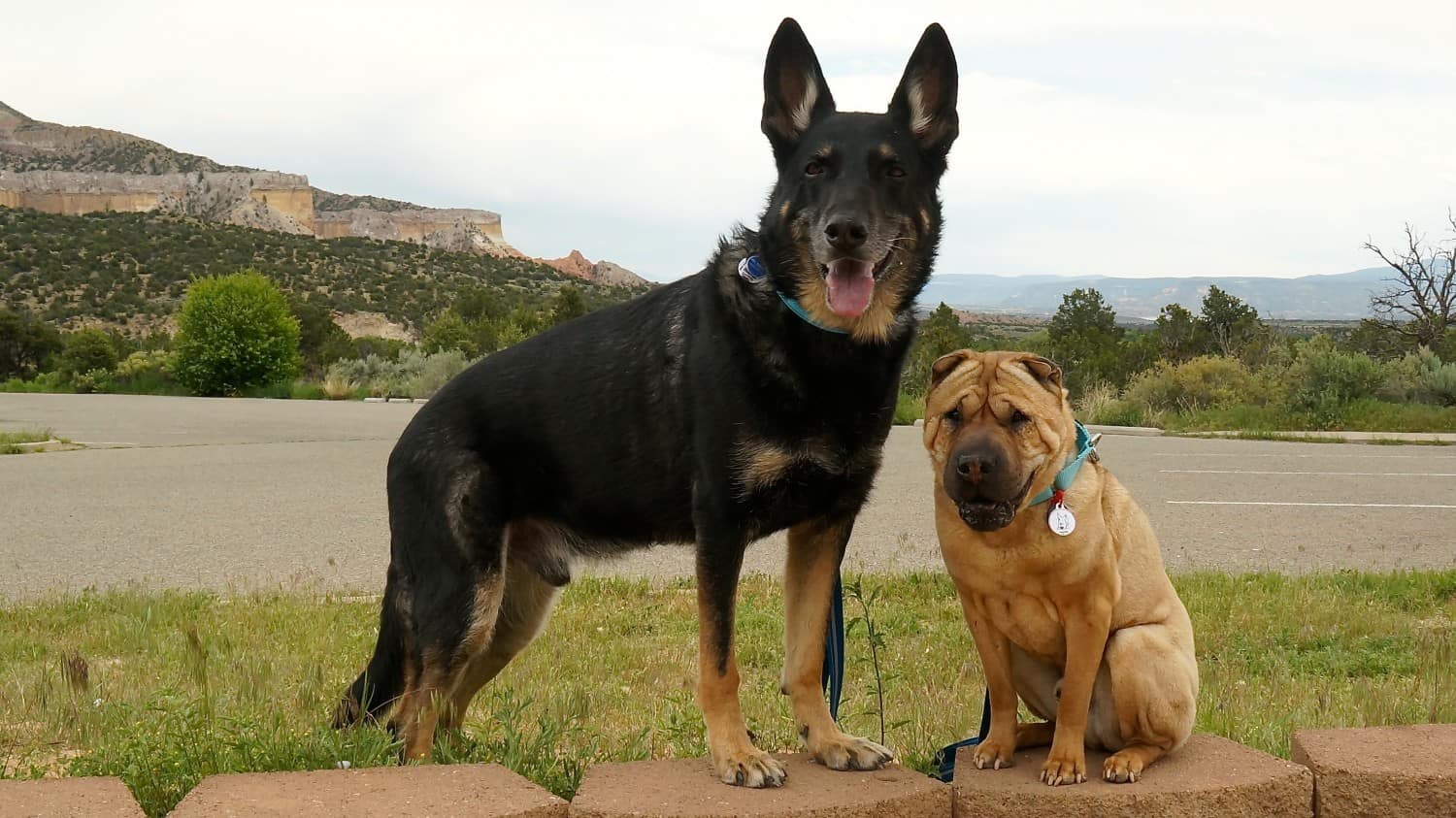
All that research came in handy when we adopted Maynard last year. At 12.5 years old, he was struggling with arthritis in his elbow and had a pronounced limp. Ten months later, he’s much more spry and active! And we’re delighted to see him bounding for the door when it’s time to go for a walk or hit the trails.

Arthritis In Dogs
Studies show that as many as one in five dogs suffers with arthritis. It can strike dogs of any age. So learning to recognize the symptoms will help you know when to talk to your veterinarian about your dog’s condition.
Symptoms Of Arthritis In Dogs
The signs of arthritis can be subtle, and many dogs are excellent at hiding their discomfort. Here are some behaviors to watch for:
- Lameness and/or stiffness (especially after rest)
- Struggling to rise after resting
- Hesitancy when laying down
- Walking slowly
- Lethargy and tendency to sleep more
- Depression
- Muscle weakness
- Swelling of the joints
- Licking the joints
- Weight gain or loss
- Nervous or aggressive behavior
- Reluctance to jump or be active
- Squatting to urinate or urinating indoors
Buster started showing some of these symptoms at around 10 years old, which wasn’t surprising for a German Shepherd. And Maynard had most of these symptoms when he came to live with us. For both dogs, we started with x-rays and blood work to rule out other possible causes. Then we sat down with the veterinarian to figure out a plan.
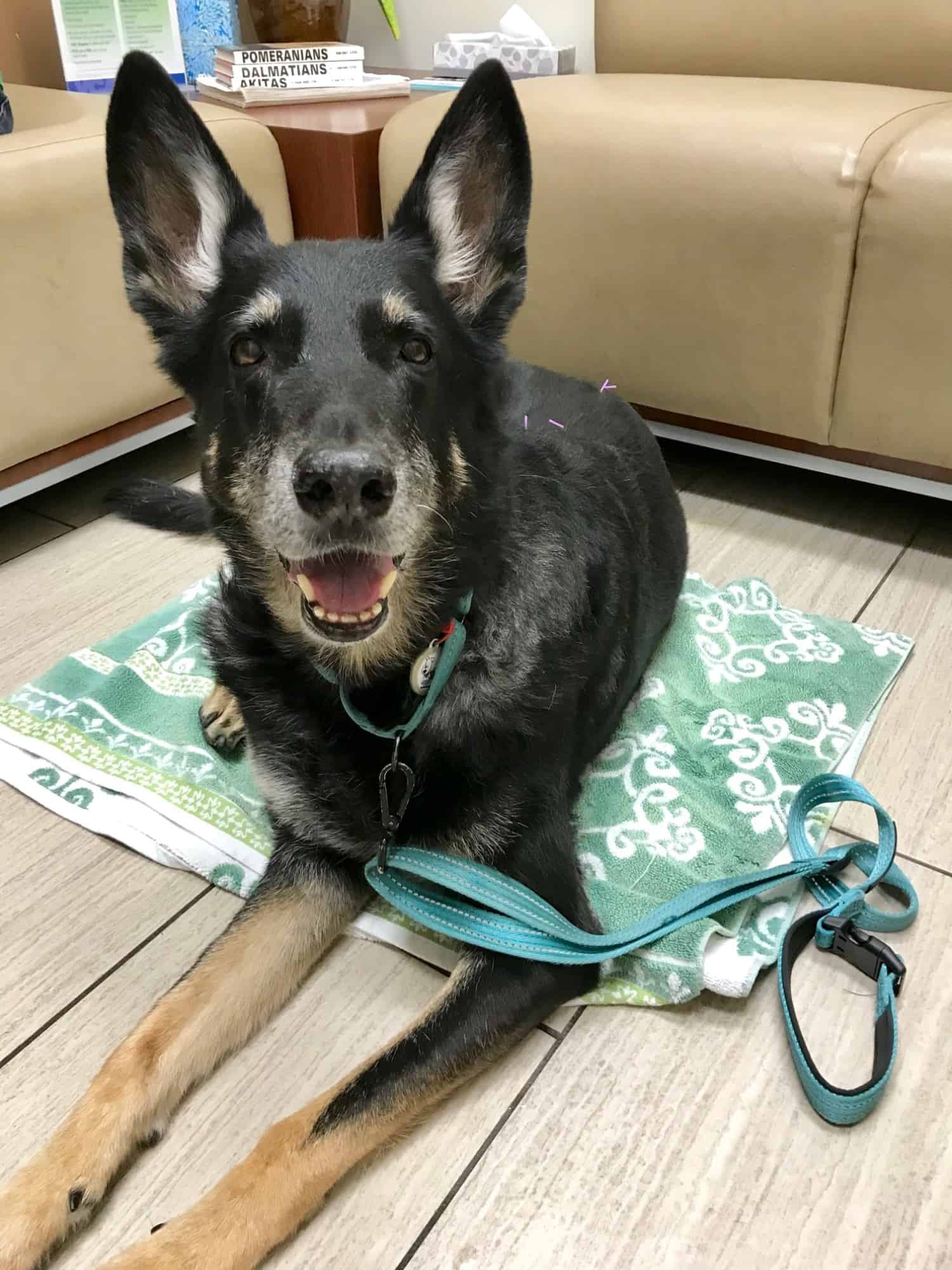
Treating A Dog With Arthritis
Meet With Your Vet
The first step in treating a dog with arthritis is to meet with your veterinarian. A number of medications and supplements are available to relieve the pain and inflammation your pup is feeling. In addition, treatments like acupuncture, physical therapy, hydrotherapy, laser therapy, magnetic therapy, stem cell therapy, and ultrasound therapy can help.
Your veterinarian will advise you on the course of treatment that will be the most effective for your dog. And once you leave the vet, there are a number of things you can do at home to help your dog deal with arthritis.
READ MORE ⇒ Could A Wheelchair Help Your Dog?
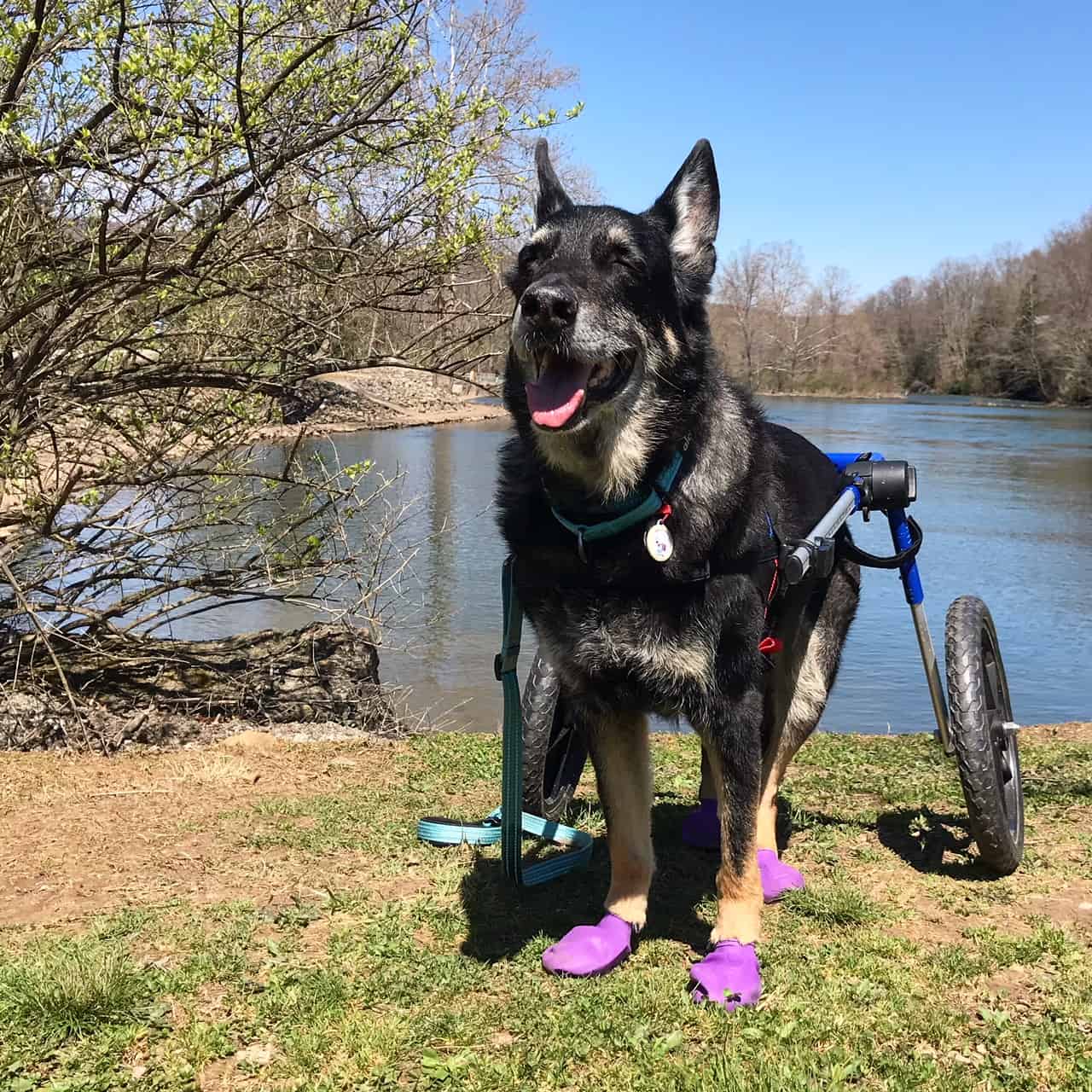
Supportive Exercise
Exercise is key in maintaining a good quality of life for a dog with arthritis. One of the things that tipped us off to Buster’s arthritis was that he wanted to walk less. And without as much exercise, he started getting a little chunky. Maynard was already 10 pounds overweight when we adopted him last year. He was struggling with a pretty serious limp, which caused us (and his previous owner) to keep his walks shorter.
When you’ve confirmed your dog is dealing with arthritis, start walking him more frequently, but for shorter distances. Moderate exercise helps reduce joint pain, helps with weight loss, and keeps muscles toned to support the joints. But going too far can cause additional pain and stiffness.
If it’s available in your area, swimming is another excellent exercise for dogs with arthritis. Some veterinarians could even recommend hydrotherapy, where under-water treadmills make walking a lower impact activity.
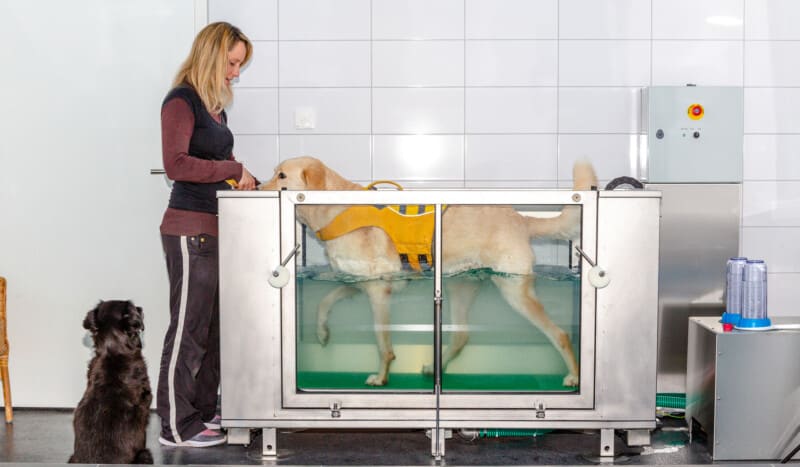
Adjusting Your Dog’s Diet
Carrying extra weight is also hard on the joints, which arthritis makes especially painful. Determine your dog’s target weight with your vet. Then reduce his food portions and treats to correspond to his lower activity levels. This will help him slowly drop the pounds, which will decrease the pain he’s feeling, and give him more energy. As he feels better he’ll probably want to exercise more, so adjust his food portions to keep him at his target weight.
Another major factor in treating arthritis is a healthy diet with natural ingredients to help the body heal the inflammation of arthritis. Our dogs have always loved The Honest Kitchen dog food. It’s a human-grade pet food that’s gently dehydrated and contains no additives or preservatives. We attribute Ty and Buster’s long lives to the fact that they ate so well all those years!
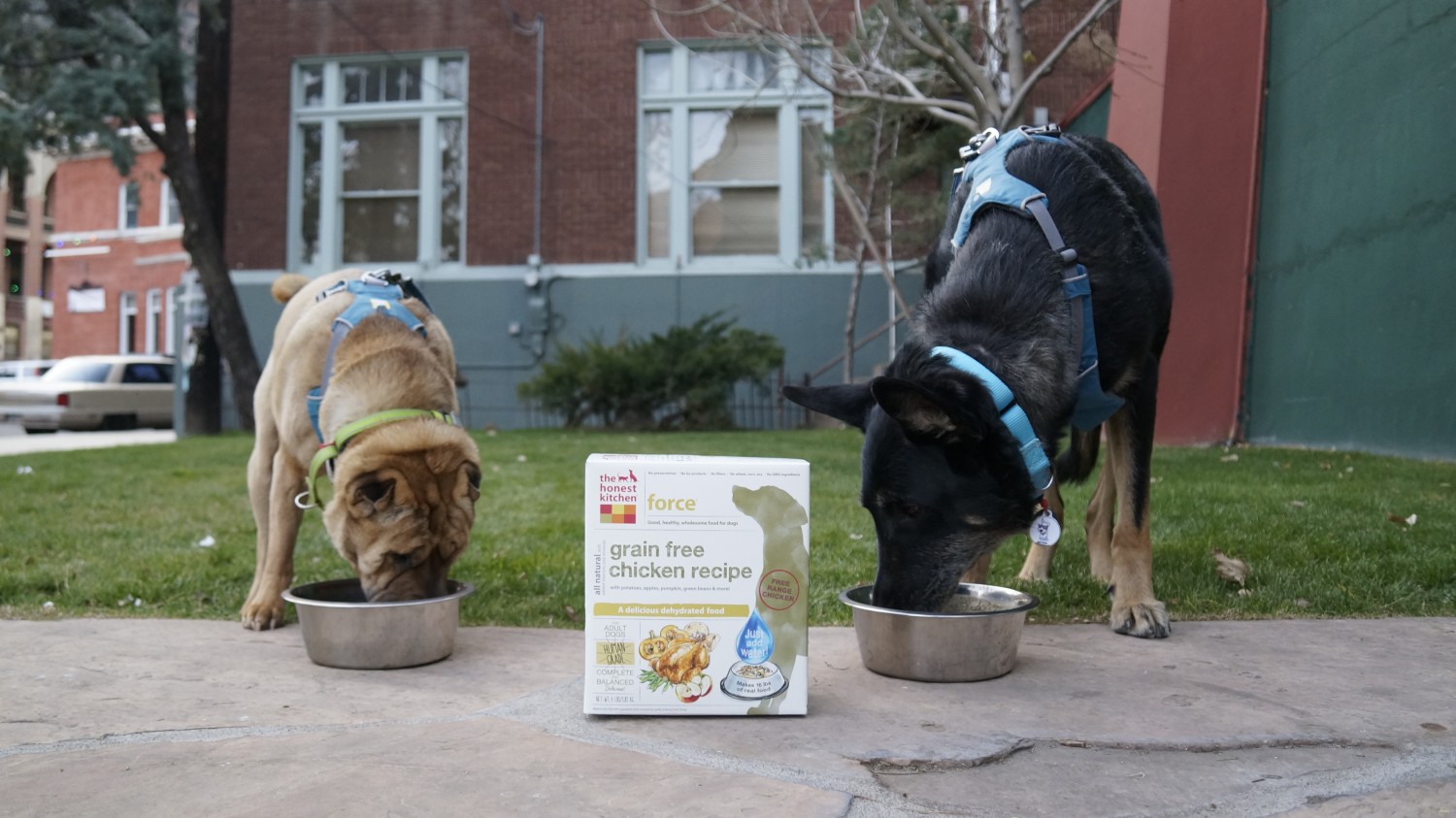
Maynard was a different story. He arrived at our home with a bag of prescription food for dogs with allergies. The first ingredient listed on the package was corn starch, which is known to increase inflammation in the body. The food he was being prescribed was likely contributing to his arthritis!
We immediately tried switching him to The Honest Kitchen dog food, but it triggered some of the worst itching and sores I’ve ever seen. So we tried another diet for dogs with severe allergies that included whole foods and no corn. It’s been a hit! Maynard loves it, and we know it’s not aggravating the arthritis inflammation.

Adding Supplements
Joint health supplements are commonly recommended for a dog with arthritis. But before beginning any supplement, you should discuss it with your veterinarian.
We discovered that there’s a prescription-strength version of the joint health supplement we were giving Maynard available through his vet. And there was a noticeable improvement in his limp after we switched him over. So be sure to talk to your dog’s vet!
Many people also use CBD to help their dogs with arthritis. Unfortunately, we can’t speak to that. We tried CBD years ago with Buster, but it increased his anxiety. And for now Maynard is doing so well on his combination of medications and supplements that we haven’t felt the need to add anything to the mix.
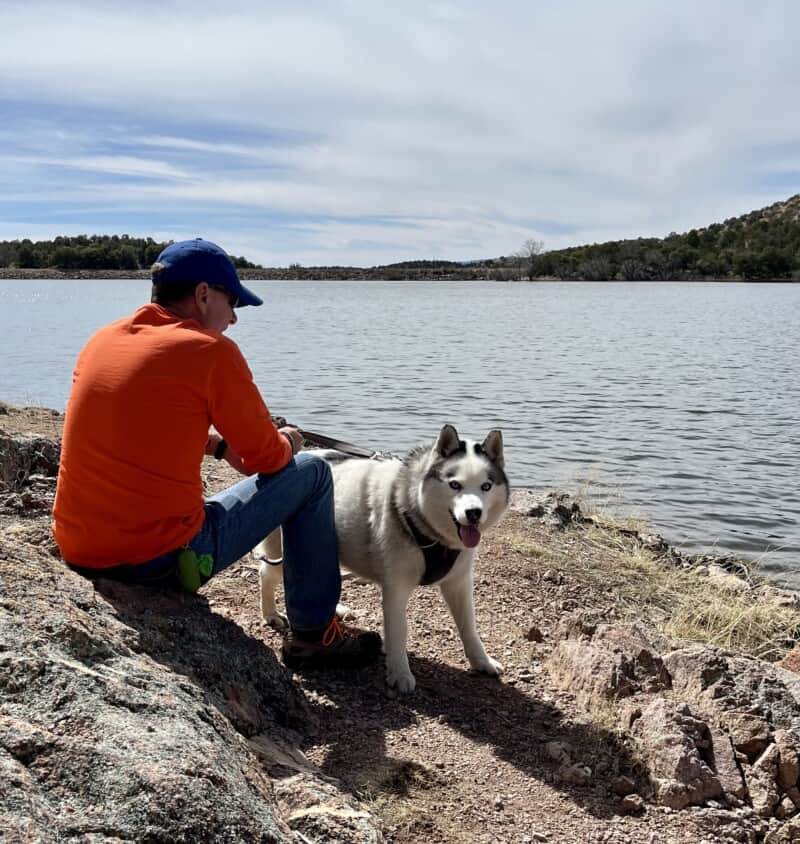
A Comfortable Place To Rest
Knowing that pets with arthritis often feel achey, it’s important to provide a comfortable place where they can rest. Buster loved to sleep on the sofa — especially if he had someone to cuddle.
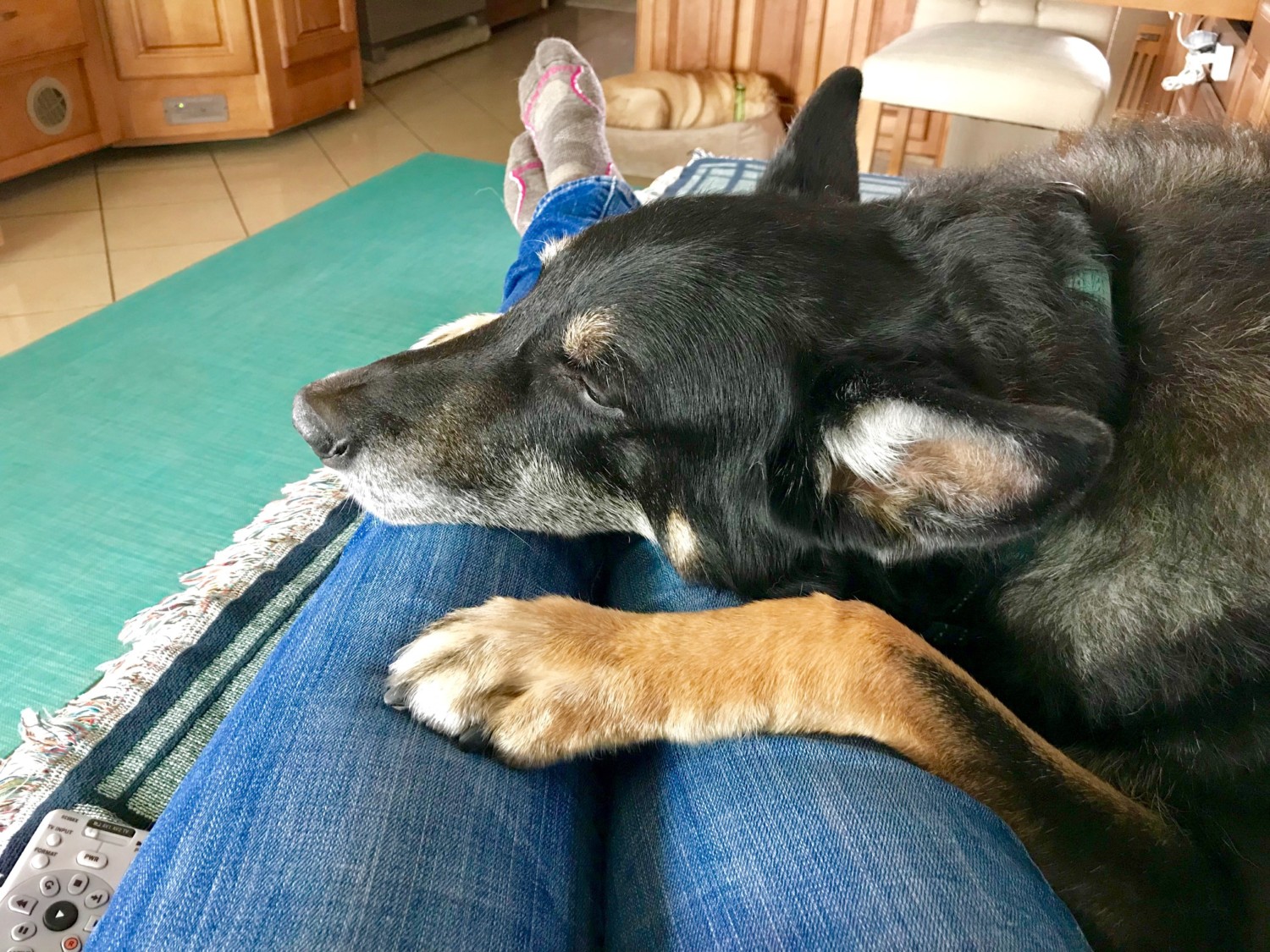
But at night he always spent an hour or so at the foot of our bed. Rather than have him on the cold tile, I tried several different dog beds in that spot. And he wouldn’t lay on any of them! But a rubber-backed bath mat did the trick. It didn’t slide when he laid down and got up. And he was happy to have something a little softer to snooze on.
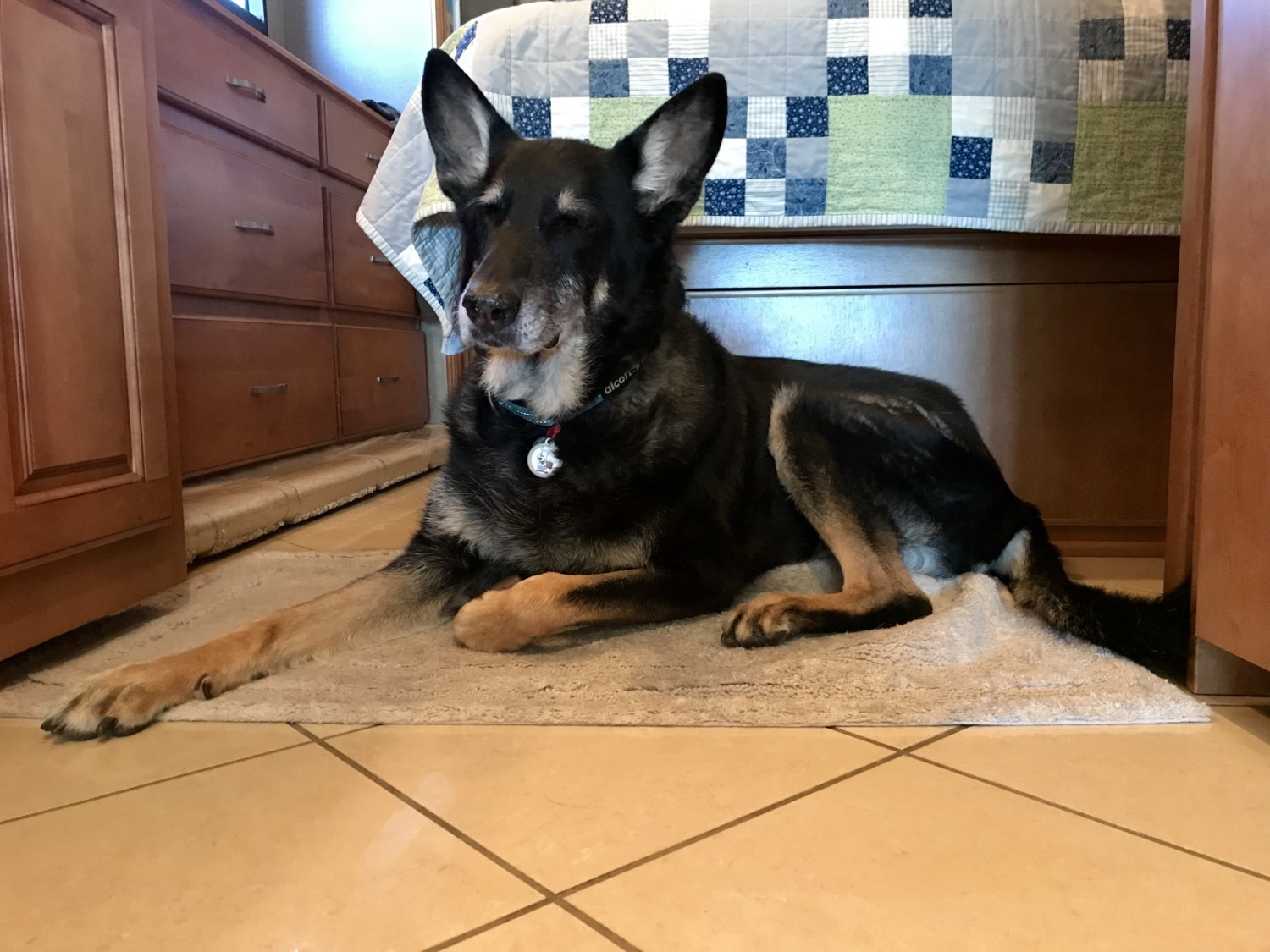
Maynard spends much of his day napping on the sofa. (When you’re 13 years old, napping is a popular pastime!) But when we go to bed, he likes to be in the bedroom with us.

We tried an elevated dog bed to help him stay cooler. But he seemed to miss the bumper sides of his regular dog bed. So we stacked one bed on top of the other, and now he’s extra comfy. Sometimes it takes a bit of trial and error to find what works!

Paw Protection
Maynard hasn’t had this problem, but as Buster’s arthritis progressed he started dragging his back paws when he walked. Because we knew how important it was for him to keep moving, and because he was always so happy to get out for a sniff, we had to protect his paws from getting scraped. Wearing dog booties was the perfect solution.
READ MORE ⇒ Which Dog Boots Are Best For Your Dog?
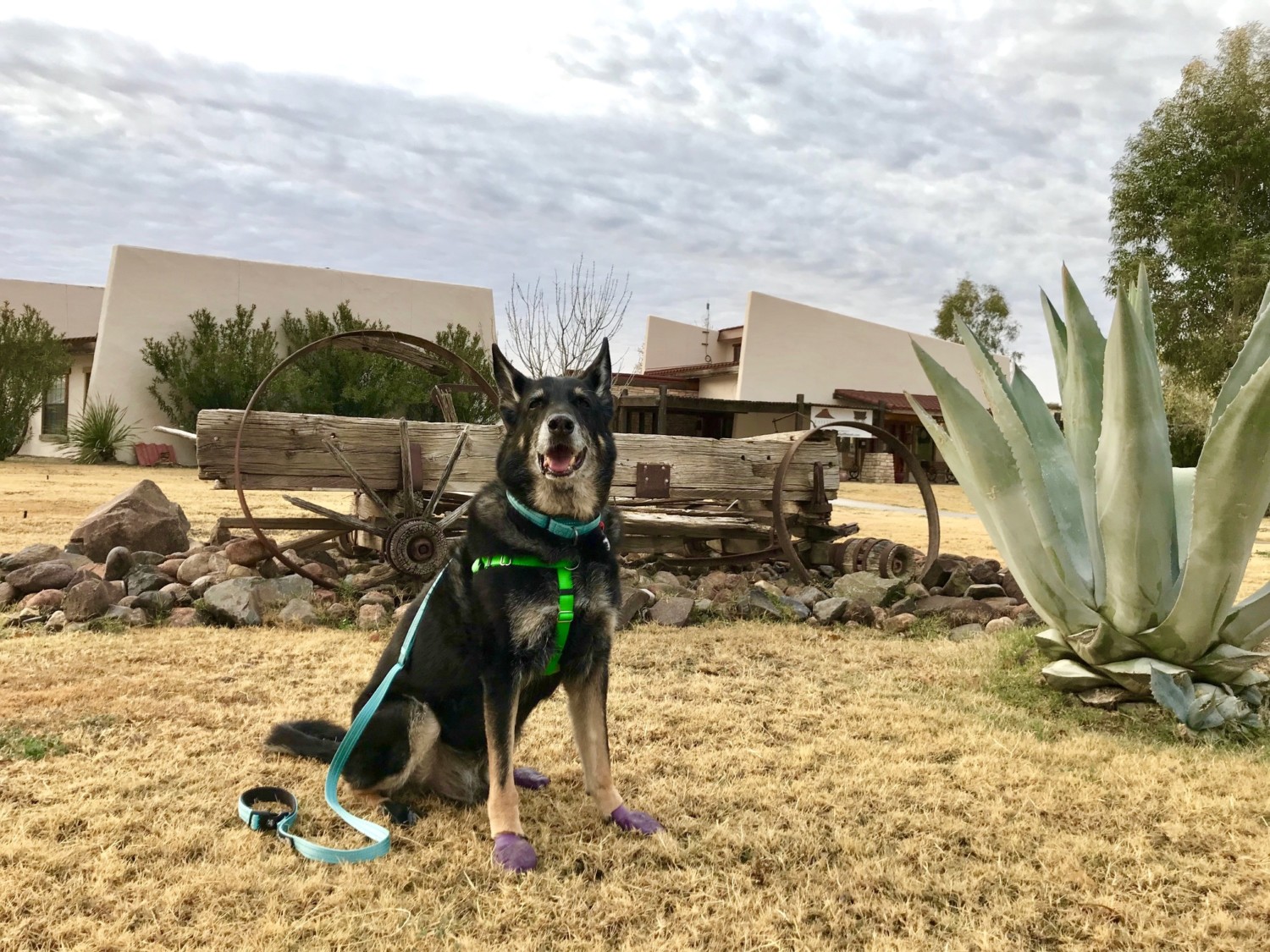
Removing Obstacles When Possible
The biggest challenge arthritis created for Buster was getting up the steps of the motorhome. With the stiffness and weakness in his hind legs, he had trouble climbing the steep incline. It was hard watching him struggle, and a few times we had to give him a boost to get to the top.
Removing that obstacle was easy. We got a ramp that helped Buster climb into the Winnebago. It was lightweight, portable, and at 8-feet long, providing a gradual slope for him to walk up. Teaching Buster to use the ramp was another challenge! But he got the hang of it, and used it for years.
READ MORE ⇒ Tips for Choosing and Using a Dog Ramp
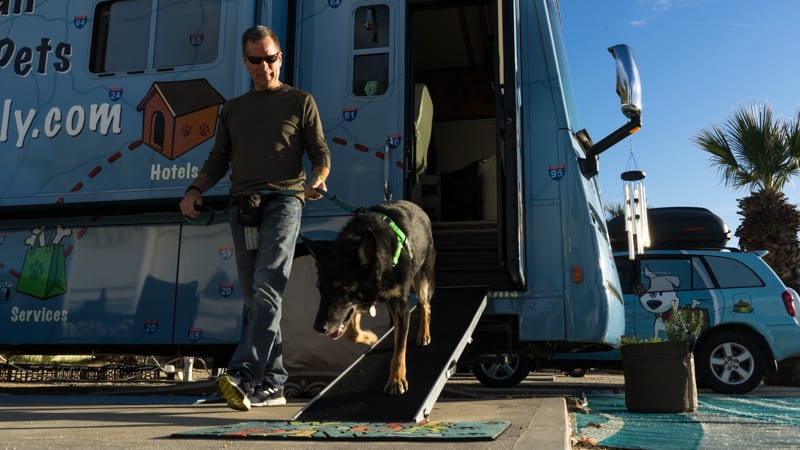
Living in a house has made it easier to accommodate Maynard’s arthritis. The biggest challenge we’ve faced has getting him in and out of the car. He really dislikes be “helped,” so we needed a solution that allowed him to jump into the back of our Jeep on his own.
With his previous owner, Maynard always rode in the cargo area of a Subaru, so that’s where he’s comfortable. But the back of our Jeep is quite a bit higher than the back of a Subaru.
Fortunately, we found platform that slides into our trailer hitch, allowing Maynard to make two smaller jumps rather than one big one.

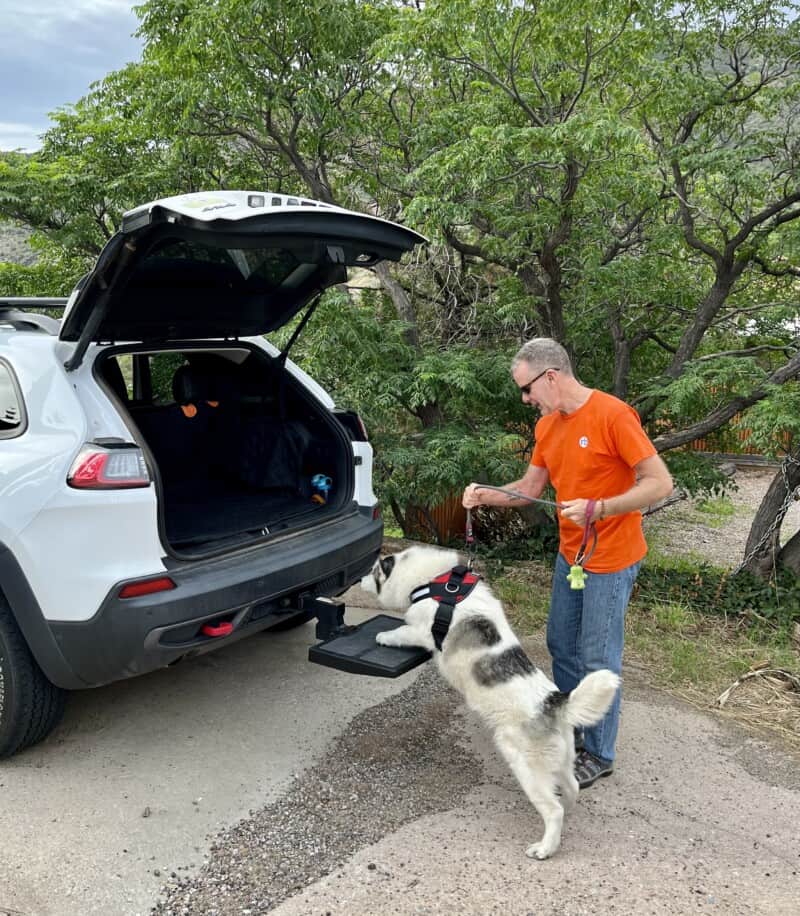
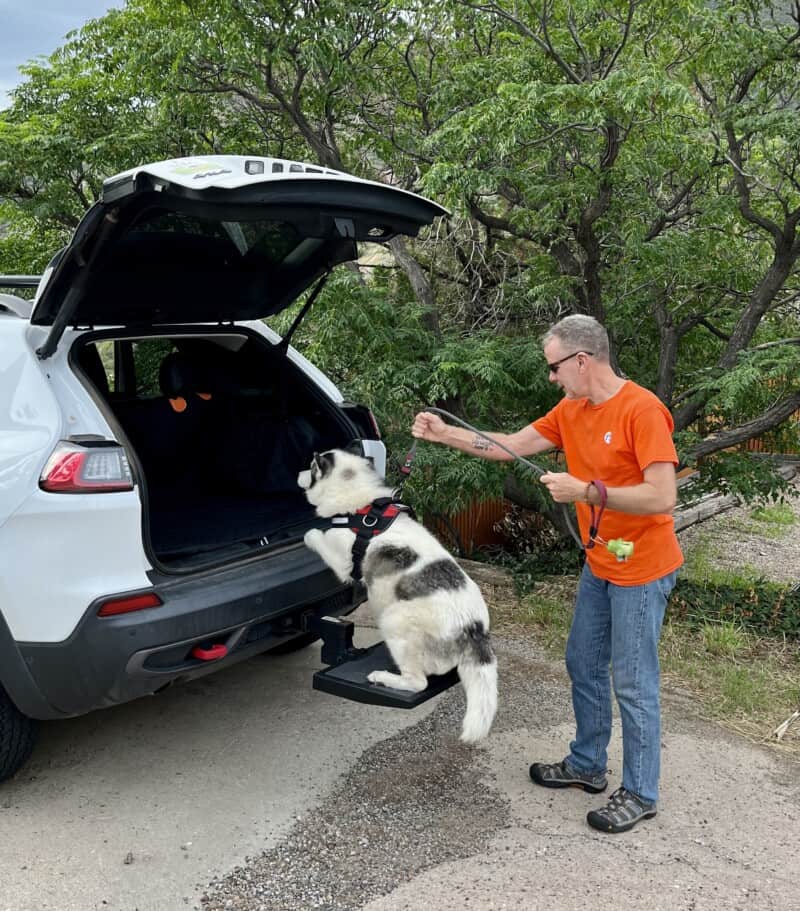
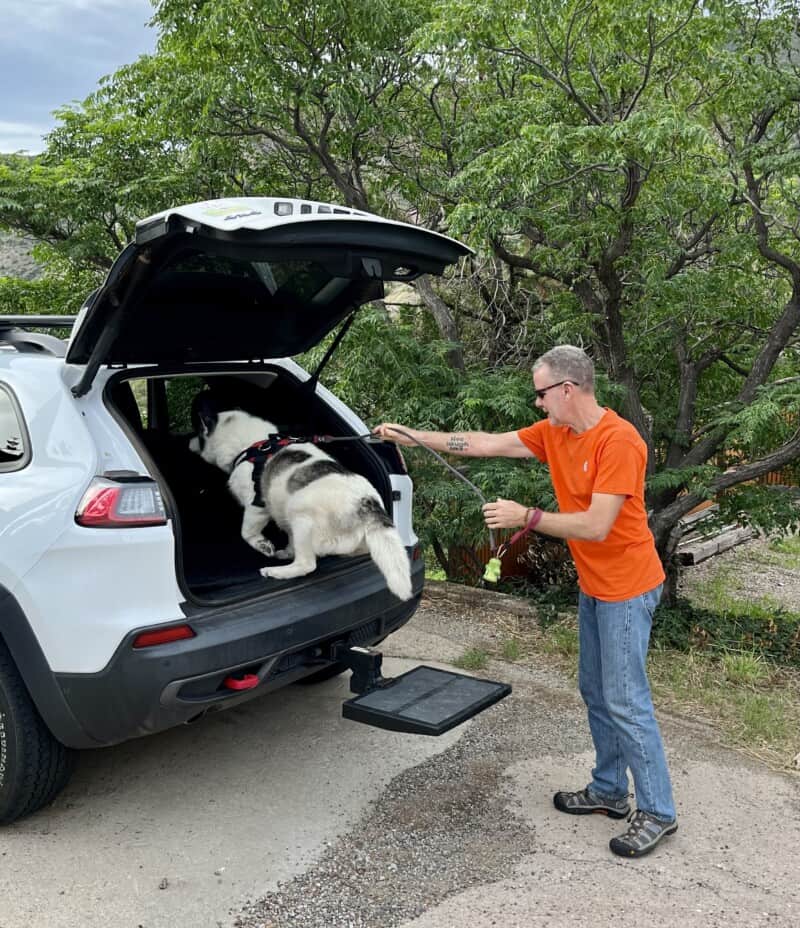
What’s Helped Our Dogs?
Life would be so much easier if our pets could just talk! Instead, we watch them closely, guess what they’re feeling, and hope we’re making the right decisions. It’s the best we can do.
There’s no way to know with certainty whether everything we did for Buster and are doing for Maynard is working. Our only clues come from watching their behaviors. These are some hints they’ve given us that they’re feeling better:
- No limping.
- Less paw licking, which we assume means there is less pain.
- Walking more quickly, sometimes even breaking into a trot.
- Playing with toys.
- More often lifting a leg to pee rather than squatting.
- Fewer stumbles.
- Hopping on and off the sofa with no hesitation.
For now, all is going well with Maynard. And, if something changes, we’ll consult with his vet to decide what treatments or medications are available to try next. Whatever it takes to keep him happy and feeling good!

Visit our Amazon store to learn about more products we rely on to make traveling with pets easier, safer, and more fun!
Amazon Affiliate Disclosure: GoPetFriendly.com LLC is a participant in the Amazon Services LLC Associates Program, an affiliate advertising program designed to provide a means for website owners to earn advertising fees by advertising and linking to amazon.com, audible.com, and any other website that may be affiliated with Amazon Service LLC Associates Program. As an Amazon Associate, the owner of this site earns a commission from qualifying purchases.
